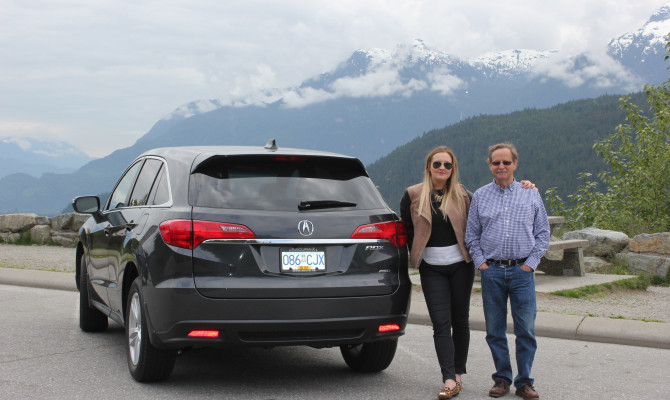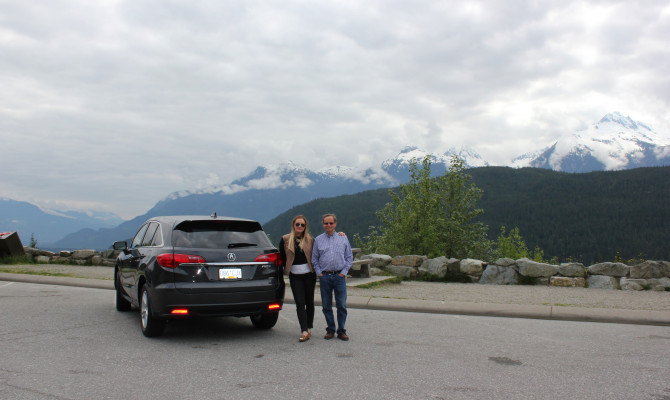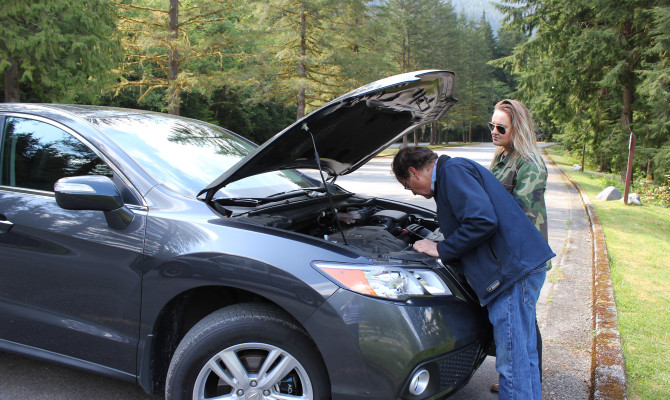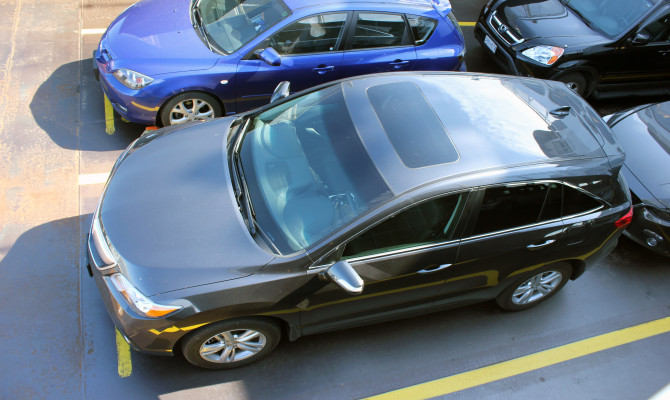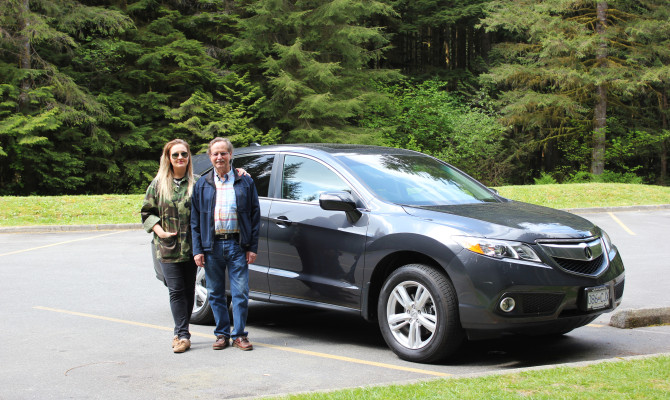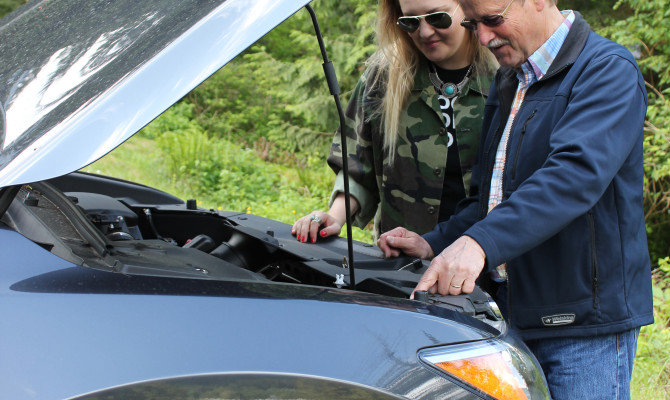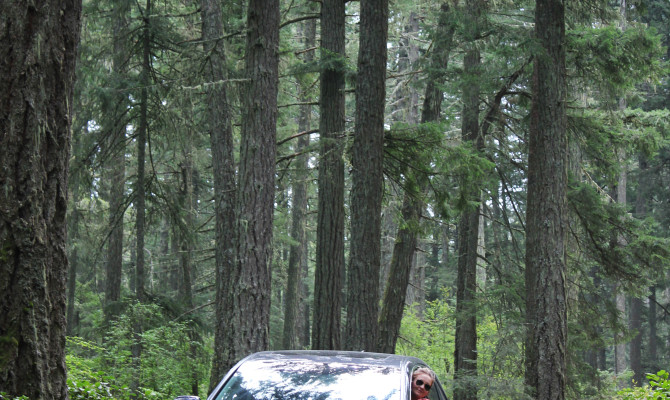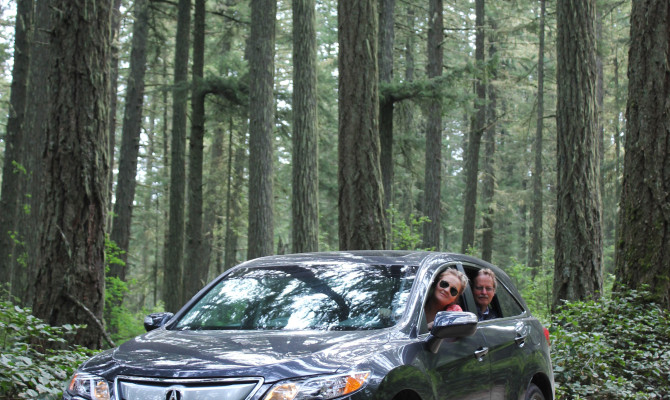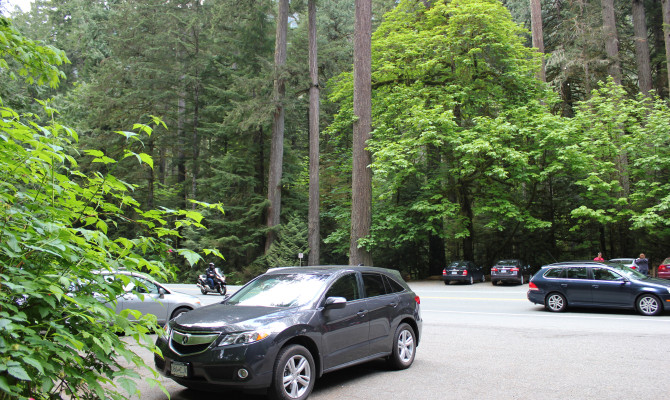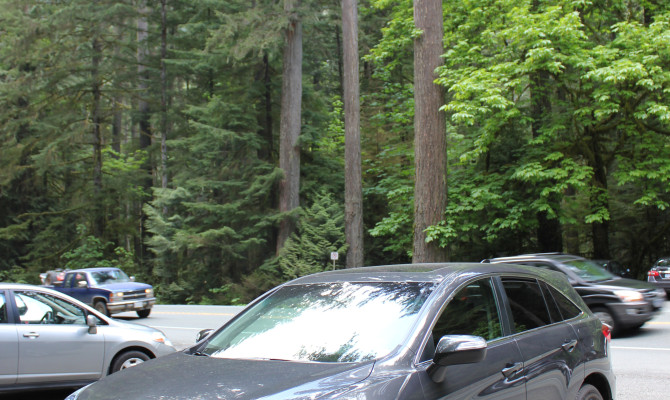“A six-day, 1,200-kilometre, road trip in an RV through some of the most spectacular scenery this province has to offer…” (more…)
by Hayley Thomas
“The pleasure of cruising the coastline was amplified by the views offered from the RDX’s raised stance.”
Exploring beautiful British Columbia for the first time should enjoyed in the comfort and views offered by a high-end sport-utility vehicle.
Having recently moved to the province from Nova Scotia, it was time for my parents to make their first trek to this side of the country, so the pressure was on to find an appropriate vehicle to show off my new ‘home’.
A 2015 Acura RDX was available in the media fleet: Its 273-horsepower, 3.5 litre V-6 engine, along with a 6-speed automatic transmission, persuaded me it would get us where we needed to go.
My parents, Nadine and George Thomas, started their trip in Vancouver, in the heart of the city. On the first evening I offered to take them for a drive around town to show them the hot spots. The RDX offers soft leather seats featuring 8-way power adjustability, coupled with a very sleek and stylish exterior, which incorporates an aerodynamic efficient body. To say we felt cool driving it through the city, with music pumping from the 360-watt audio system, is an understatement.
Within a few days, we were on our way to explore Salt Spring Island. At this point, it was time for my father to get his hands on the wheel to see what the RDX was “really made of.”
Our joint verdict is the RDX offers great handling with an agile yet secure feel – the vehicle integrates Amplitude Reactive Dampers that analyze the driver’s input against the road conditions to adjust the drive to the road you’re travelling.
Like most dads, mine never needs directions. However, when we were on our way to the Saturday Market we “somehow” ended up on a dead-end back road. Luckily, the GPS navigation system gave my mum a much-needed break from map reading. The system has the ability to pinpoint your location almost anywhere in North America, and is equipped with two options of relaying your route: either by voice or a real-time moving map. This feature is a sure-fire way of ensuring you get to where you need to go, while removing any second-guessing from the equation.
We continued our adventures on Vancouver Island from Nanaimo through the Vancouver Island mountain ranges. At this point, I once again took over driving without the hassle of re-setting my seat preferences; the settings were conveniently programmed into the seat position memory. Once back on the road I really put the pedal to the metal – the acceleration was brisk and delivered plenty of power. With that much power, typically comes a hefty bill at the gas station and not because of all the ice cream sandwiches purchased there. However, a comparison check shows the RDX offers fuel efficiency is rivalled by very few luxury SUVs. Given the often-steep gas prices we see these days, the RDX’s fuel economy on average is 10.6 litres/100 km, allowing motorists to enjoy summer drives guilt-free.
The pleasure of cruising the coastline was amplified by the views offered from the RDX’s raised stance. Driving as the sun dipped below the horizon meant it was time to open the moonroof. The moonroof is easily operated with a one-touch power mechanism along with a visor that actively reduces the vibrations and noise associated with having a window open, allowing for a smooth and noise-free ride.
Last, but certainly not least, I had long been awaiting my parents’ arrival with the anticipation of finally properly learning how to parallel park. Much to my surprise, the Acura RDX provides all of the tools required to successfully complete this complex and sometimes dangerous (when I’m behind the wheel) task. The vehicle includes a multi-angle rear-view camera along with reverse tilt dual mirrors that provide curb views. I can now parallel park in the city without chagrin – hold onto your curbside parking spots, fellow motorists.
2015 Acura RDX
Base price: $41,390
Price as tested, Tech edition: $44,390 – plus $1,995 freight & pdi
Today, we conclude our look at so-called Curbers: con artists dedicated to separating you from your hard-earned cash by selling you a vehicle that is not all it seems to be…
Bringing a curber conman to justice can cost tens of thousands of dollars.
While penalties can be high, many successful prosecutions may yield a fine of just a few hundred dollars. One case currently before the courts is five days into a trial over a $288 ticket. The costs to date of further action against the offender are now approaching $80,000.
At first sight, one might think it appropriate to save public cash but the problem is allowing a dismissal to occur sets a dangerous precedent that could harm future prosecutions.
Because the matter is still before the court, the accused’s name is withheld but the circumstances can be revealed because they are instructive. The Surrey man has undergone continuous legal action by the VSA (in partnership with the City of Surrey). The Provincial Court found him guilty on three charges of curbing. He continued to curb so the VSA obtained an injunction from the BC Supreme Court. That did not deter him so the VSA applied to the BC Supreme Court to find him in contempt of court. If successful the man will face a fine of $10,000 if found curbing again.
This form of con clearly can be very profitable, if the perpetrators figure fines and legal expenditures are merely the cost of doing business. However, the following cases illustrates typical curber practices and the penalties they could face.
One prolific curber was convicted with 31 counts of fraud. He was buying vehicles wholesale from licensed dealers and selling them to the public. He rolled back more than two million kilometres. He was fined $31,000, two vehicles were seized from him, and he was put on probation for three years.
A curber from Williams Lake claimed he sold cars as a hobby. After several tickets and warnings from the VSA, Crown Counsel issued court charges against him. After pleading guilty, he was fined $2,000. The legislation allows for a maximum fine of up to $100,000 for individuals and $200,000 for corporations.
A Delta man was convicted of fraud – 15 charges with evidence of odometer tampering, inaccurate vehicle histories, sales tax violations and other deliberately deceptive practices. Crown Prosecutor said he targeted the most vulnerable consumers, such as recent immigrants who had poor English. There was deliberate planning to perpetrate each fraud – finding a low priced vehicle, rolling back the odometer, detailing to improve the appearance of the vehicle, creating a false history, finding a suitable “victim,” forging official documents and tax fraud. This occurred on more than one occasion.
As the buyers were “complicit” in the fraud, there was no consumer restitution for 12 of the 15 counts. They agreed to false documentation to save on taxes – a common practice used by curbers. This makes consumers fearful to go to authorities when something goes awry.
He received a one-year conditional sentence (effectively house arrest, except for medical emergencies or to work, with the terms easing as the year progresses). He also agreed to perform 100 hours of community service.
I’m indebted to the Vehicle Sales Authority of BC for providing the research necessary for produce last week’s typical curber profile story and today’s account of real scams. Please, if you don’t want to buy from an established dealership, do your due diligence as to the registration and condition of the vehicle you plan to buy.
Ice and snow can hit unexpectedly at this time of the year.
This is a good time to make sure your tires are rated for the conditions you may be driving in and check your tire pressure regularly – pressure drops in cold weather and overinflated tires can reduce gripping.
I keep hearing TV F1 commentary teams talking about the perfect race in relation to the now four-time world champion Sebastian Vettel.
As I watched the German driver for Infiniti-Red Bull race team take the chequered flag in India on Sunday, the repeated reference to his perfect race reminded me of another open-wheel racer.
Back in the early 1990s, Vancouver Indy racer Ross Bentley strived for what he called the ‘Perfect Drive’, not on the track but on the roads of B.C.
Ross, now coaching race drivers and street drivers in Washington state, always told me that he found the racetrack a safer place to drive. On the track he pretty much knew what other drivers were going to do, whereas drivers on the street were very unpredictable.
And I was reminded of that the other morning when a young driver whizzed by me in the curb lane, then cut in front and crossed two more lanes to turn left at an intersection just a block ahead. Of course, he didn’t signal when he got there, either!
Ross devised a little game that he played every day while travelling to and from work across town. The Perfect Drive Concept was designed to help drivers concentrate and I can’t help think it would be a great game for us all to play some 20 years on from when he first outlined the idea to me.
“The idea is to drive smoothly at a constant speed with minimal braking,” explains Ross, who tells me he still tries to achieve the Perfect Drive daily.
“To do so, you must anticipate light changes and ease off when you approach a stale green. You have to slow in such a way that if your passengers had their eyes closed they wouldn’t be aware of the exact point you stopped.”
Keeping a healthy distance between your car and the one you are following is key. Others do cut into the space but they disappear as fast as they arrive. And even if you ease off to open up the gap again, Ross figured if even 10 cars did that to you and stayed during the average trip you might lose a minute in travel time.
“The Perfect Drive can be ruined by others so I try to figure out what crazy things they might do and adjust accordingly. If I have to brake jerkily in anticipation of the other driver’s move, I don’t deduct any points!”
However, if you hold up traffic or disrupt the flow then you deduct points. If you can let somebody in smoothly or provide an opportunity for somebody else to turn then you’re assisting the flow so he figured that was worth a few bonus points.”
“The Perfect Drive can be different for everybody and you can work out your own scoring technique. I keep it simple and figure if I drop four points then that was nowhere near the Perfect Drive.
I love his final comment: “Oh, and if you drop a point halfway through, you don’t give up and drive the rest of the way like a jerk.”
Give it a try, it’s fun.
Contact:
Email: keith [dot] morgan [at] drivewaybc [dot] ca
Twitter: @ChangeGears
It can be very difficult, if not impossible, to tell if tires are under-inflated just by looking at them. Yet most drivers don’t check tire pressure regularly. Proper tire pressure saves money, fuel consumption, helps the environment – and saves lives. Having TPMS on vehicles helps to keep Canada’s roads safe by giving drivers the critical warning they need when one or more of their tires has low air pressure.
Facts on Maintaining Proper Tire Pressure:
Saving lives – vehicle safety and performance
Under-inflation is the leading cause of tire failure. Even if your tires look fine, they could be under-inflated by as much as 20 per cent.
According to a recent study, about 50 per cent of the vehicles on the road in Canada have at least one tire that is either over or under-inflated by more than 10 per cent. In fact, 10 per cent of all vehicles surveyed had at least one tire under-inflated by 20 per cent.
When your tires don’t have the right amount of air, the sides flex, bend and build heat. Under-inflated tires compromise your vehicle’s steering, braking and cornering abilities.
Operating a vehicle with just one tire under-inflated by 8 PSI can reduce the life of the tire by 15,000 km.
Saving fuel and the environment
Annually, 643 million litres of extra fuel are consumed by Canadian vehicles because of improper tire maintenance practices. As a result, over one million tonnes of carbon dioxide are unnecessarily released into the environment.
Canadians dispose of 29 million used tires every year, which has a significant impact on landfills. Even modest improvements in extending tire life could have a significant positive impact on our environment as energy used to produce new tires emits harmful pollutants into the atmosphere.
Saving money
Fuel consumption increases by one per cent for every five per cent of under-inflation. Operating a vehicle with just one tire under-inflated by 8 PSI can reduce the life of the tire by 15,000 km and can increase the vehicle’s fuel consumption by four per cent.
Example:
- If fuel costs $1.32/litre and it takes approximately 9.1 litres per 100 km = $12.01 / 100 km.
- Increasing fuel consumption by 4 per cent = $12.47/100 km
- If you average 22,000 km / year, you would save $100 annually ($2642 vs. $2743) by keeping proper tire pressure
Maintaining proper tire pressure could save you approximately two weeks of fuel a year, enough to pay for one full set of tires over the average nine-year life of a vehicle.
Under-inflation also reduces tire life. Driving with tires that are under-inflated by 8 PSI will increase tire wear by 16 per cent (approximately 15,000 km). This will hit your pocketbook as you will have to replace tires sooner than you would if they were properly maintained.
Tire Pressure Monitoring System
TPMS will trigger the dashboard symbol to illuminate when one or more tires are under-inflated by 25 per cent.
TPMS improves your vehicle’s handling and stability, decreasing your chances of catastrophic tire failure and having an accident.
While not currently mandated, an estimated 70 per cent of new vehicles (models from 2007 and after) sold in Canada are TPMS-equipped.
Starting in 2007, TPMS became a legislated feature on all passenger vehicles sold in the U.S.
Tips for Drivers:
Get in the habit of manually checking your tire pressure at least once a month or before a long road trip. Even if your vehicle has TPMS installed, regular tire maintenance is the best way to increase your safety.
The best way to get the most accurate reading is to check your tire pressure before you drive, when the tire is cold.
To determine if your vehicle has TPMS, look for the TPMS symbol on the dashboard when you first turn your key to the on position. Consult your owner’s manual for more information.
When installing winter tires or buying new wheels, be sure to have TPMS sensors installed in the wheels. Failure to do this will make your TPMS inoperative.
Large temperature drops, usually during winter, can cause the low tire pressure warning to come on. Have a tire service centre properly check your tire pressure and TPMS if this happens.
TPMS batteries, expected to last between five and seven years (or approximately 140,000 – 160,000km per year), are encased and can’t be replaced. Since some of the first TPMS-equipped vehicles have now been on the road for more than five years, drivers will soon need to see TPMS specialists for maintenance. Once the battery dies, a new TPMS sensor must be installed.
When the TPMS illuminates on your dashboard, it means one or more of your tires may be at least 25 per cent below recommended inflation pressure. Pull over and check your tire pressure. Once checked, if the tires appear normal, proceed with caution to a tire service centre to have them properly inspected.
A tire’s number one enemy isn’t road hazards; it’s under-inflation. Most drivers know low tire pressure can lead to skidding, hydroplaning and blow outs, even losing control of a vehicle. Yet most people aren’t aware of a tire pressure monitoring system (TPMS) in their vehicle and they don’t recognize the low tire pressure light that could save their life.
According to Transport Canada, a recent study indicated that about 50% of the vehicles on the road in Canada have at least one tire that is either over or under-inflated by more than 10%. In fact, 10% of all vehicles surveyed had at least one tire underinflated by 20%. This represents a real safety issue. Canada Safety Council states that under-inflation is the leading cause of tire failure. In the U.S., the National Highway Transportation Safety Administration estimates 660 people per year are killed as a result of under-inflated tires.
Low tire pressure has a big impact on road safety. Since you can’t always tell if a tire’s pressure is low just by looking at it, tire pressure monitoring systems were created to warn drivers when this happens. The symbol, which illuminates on the dashboard, appears like a treaded horseshoe surrounding an exclamation mark.
“TPMS is such an important safety feature, but we’re finding a lot of drivers don’t know what TPMS is and there is skepticism about its value,” says Carey Hull, director of retail products, Kal Tire. “Just like seatbelts and air bags, TPMS can save lives. We want to help Canadians understand TPMS, what the warning light looks like and what to do when they see the symbol light up on their dashboard.”
A tire loses its ability to manage the vehicle’s weight when pressure drops as little as five per cent. As a result, steering, braking and suspension can suffer. If the TPMS senses your tire is under-inflated by 25 per cent or more below the vehicle manufacturer’s recommended air pressure, the TPMS symbol illuminates on your dashboard. This is a warning to pull over and check your tire pressure. Once checked, if the tires all appear normal, proceed with caution to a tire service centre to have them properly inspected.
“Ideally, everyone would check their tire pressure monthly, long before it’s ever under-inflated by 25 per cent, because at that point, you could be in danger,” says Hull. “Ideally drivers would never see the TPMS symbol illuminate on their dashboard, but if they do, we want them to be able to respond appropriately.”
Starting in 2007, TPMS became a legislated feature on all passenger vehicles sold in the United States, the first country to mandate TPMS. Today, nearly 70 per cent of new vehicles sold in Canada are TPMS-equipped, but the feature isn’t mandated here.
Schrader International, the leading supplier of TPMS sensors, valves, tools and training, predicts that over the next decade, TPMS will be a standard safety feature on all vehicles globally.
“Initially, there was a lot of skepticism from people in the US as well,” says Trevor Potter, vice president sales and marketing, North America, Schrader International. “Drivers didn’t yet understand the value of having a system that automatically detects low tire pressure, but that’s changed in the last few years. In the US, more and more people know what it is now, and they appreciate it.”
We are approaching a busy season for winter tire changeovers. Consumers should be aware of what needs to be done to the TPMS in their vehicle when changing tires. If a new set of wheels are being purchased with new tires, new TPMS sensors may need to also be purchased and the system will need to be reset. If a set of tires are being installed on existing rims, then TPMS service will be required.
The extra service fee charged to ensure the system is working on new tires sometimes confuses and upsets Canadians who haven’t heard of TPMS, says Hull. “There is a sense of frustration from people when they come into the store and they have to have TPMS work done, but once we explain what it is and that it could prevent tire failure, people are more accepting.”
When new vehicles first started entering Canada with TPMS installed, Kal Tire chose to embrace the technology and the safety it gives drivers. All Kal Tire technicians are fully trained in TPMS procedures and are equipped with the latest diagnostic tools in order to ensure the TPMS is working properly.
Maintaining the TPMS in a vehicle may cost a few extra dollars, but it will also save money. Tires that wear evenly last longer. Some tire manufacturers advise that just five PSI below placard pressure could lessen a tire’s life by as much as 25 per cent. Proper tire inflation also provides better fuel economy, saving money at the pump. Most importantly, maintaining the TPMS in a vehicle can save lives.
Recent Comments
- { Enjoyed your Forest of Bowland in the BMW X5M, particularly the photo of the BMW in front of the main part of Stonyhurst College where... }
- { Bantam designed the Jeep, not Willy's or Ford. The American military gave the original Bantam prototype to Willys and Ford to copy. There is plenty... }
- { All Escalades come with a 6.2-lilter V8 engine that produces 420 horsepower. A six-speed automatic is the only transmission offered and drives the rear wheels.... }
- { Alexandra is an excellent journalist. }
Popular Posts
- Journey to a ‘Sparkling’ Luxury Okanagan Resort “Four lucky readers will put a Dodge Journey’s weekend-...
- The Need For Speed: Hike Those Highway Limits More than half of those polled believe the province sho...
- Drives-U-Crazy… Erratic drivers. An early morning drive from Kelowna to Vancouver is nor...
- Readers Respond: The Pros and Cons of Increasing B.C. Speed Limits Increasing the speed limits will only increase risk to...
- Honda CR-V Review: The Compact Crossover To Get Things Done The CRV is a very stylish and aerodynamic crossover veh...


